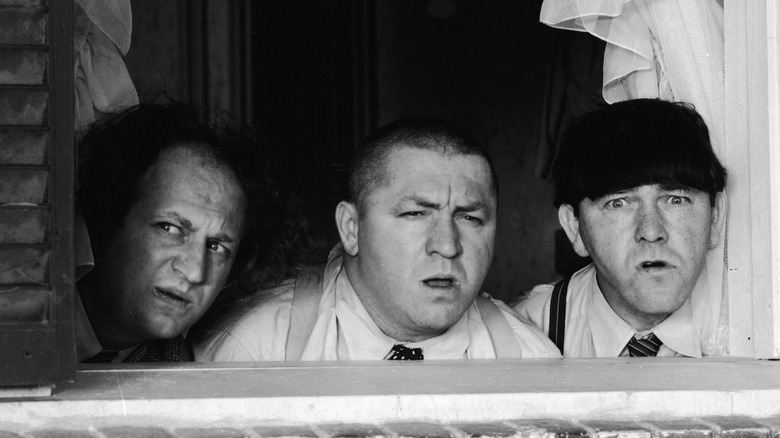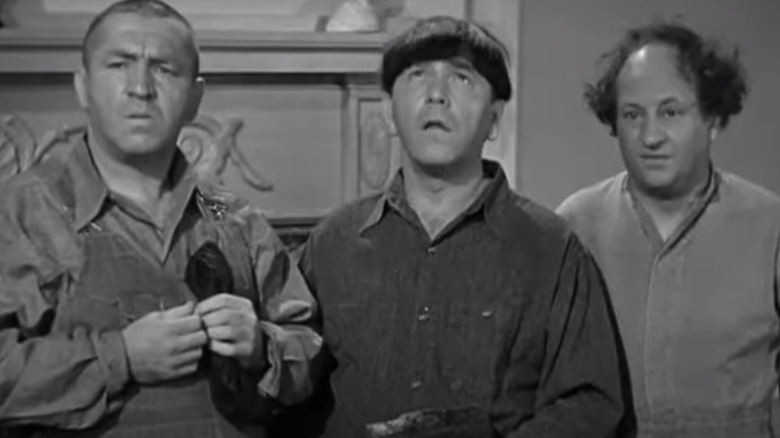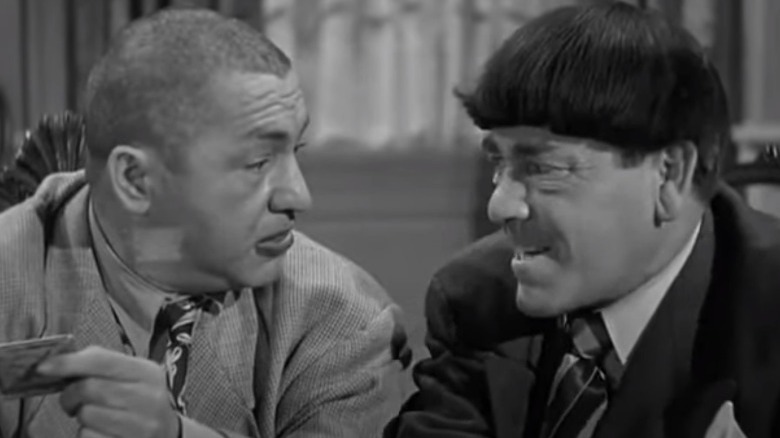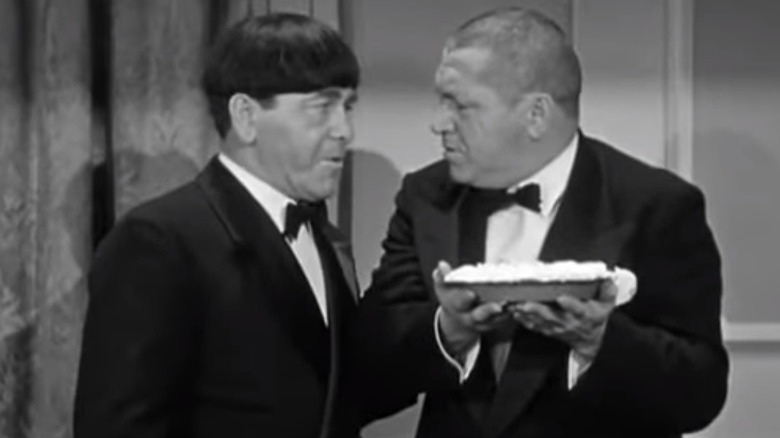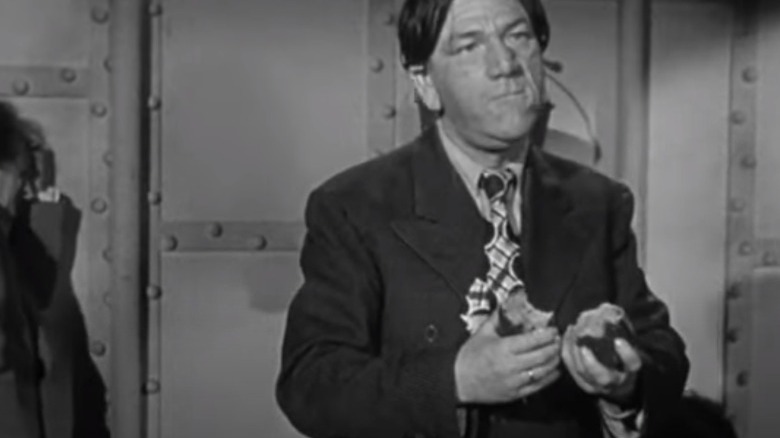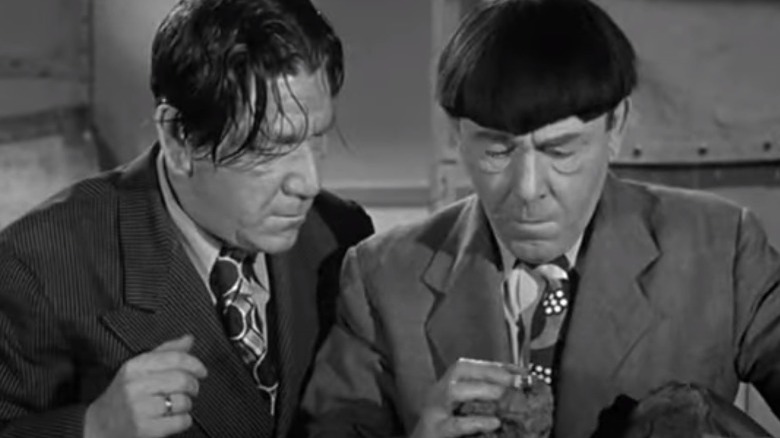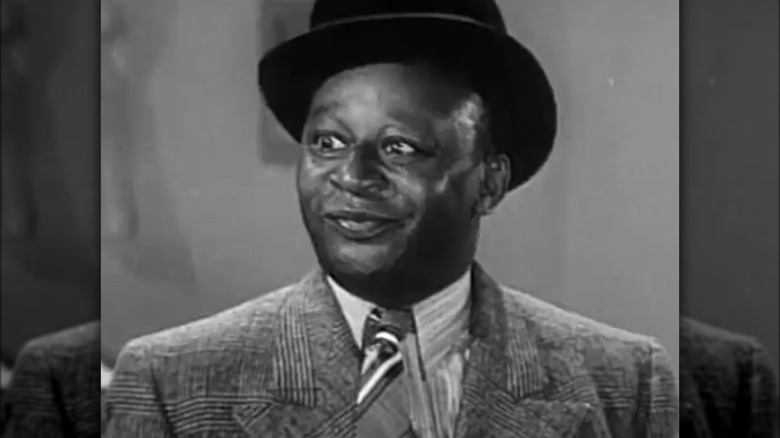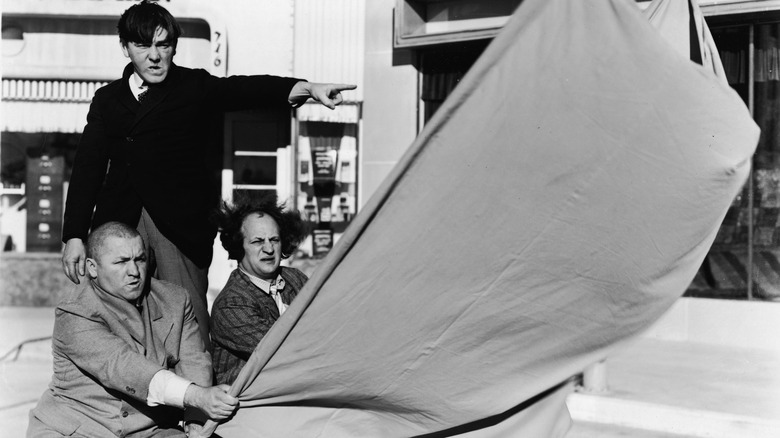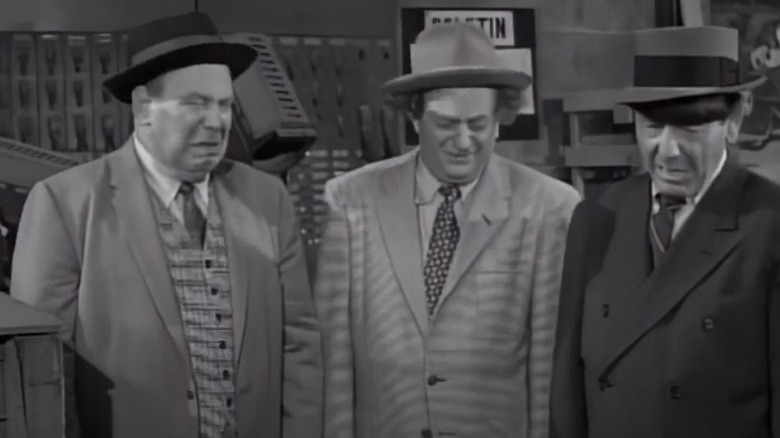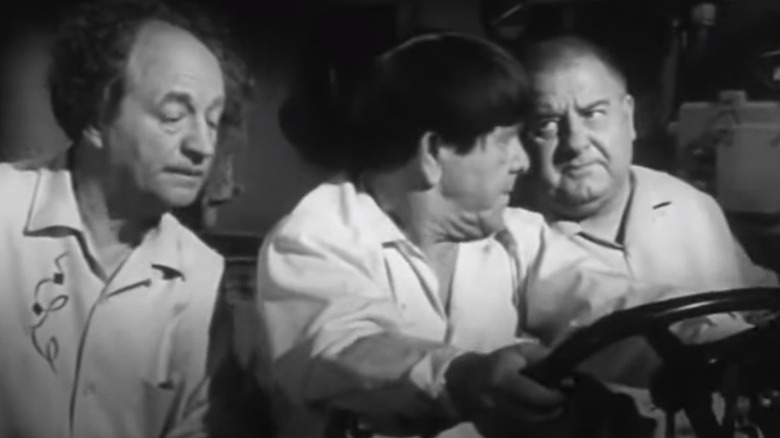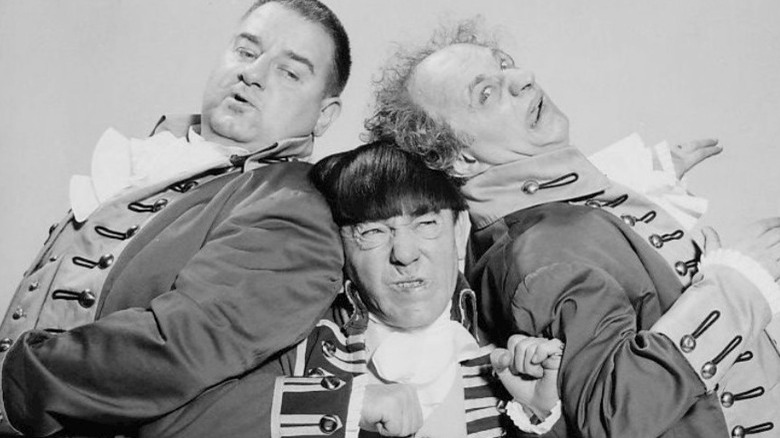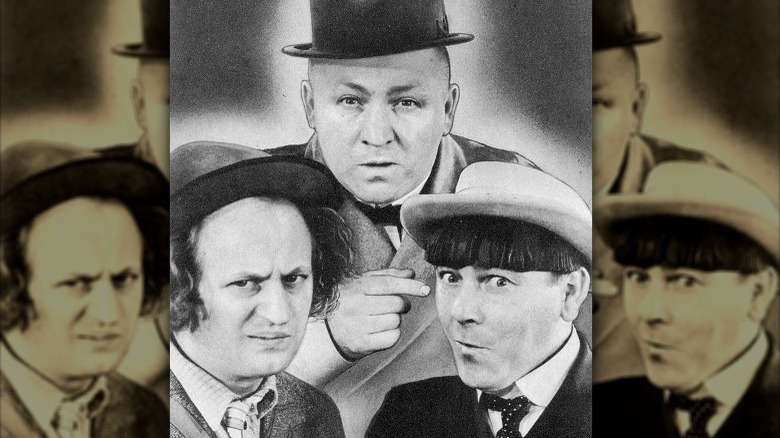What The Three Stooges' Last Movies Were Like Before They Died
There are three kinds of people in the world: those who love the Three Stooges, those who hate them, and those who say they hate them... but still can't help but laugh. Larry, Curly, and Moe's particular brand of slapstick comedy may have fallen out of style in recent years, but there's something undeniably nostalgic about sitting down to classic films and shorts.
For some, they're more than just silly entertainment. In 2019, The Washington Post reported on a small but determined movement to add 1940's "You Nazty Spy!" to the National Film Registry. Released almost two years before the U.S.'s entry into World War II, the Stooge satire fought back against Adolf Hitler in a big way. (As of 2023, the film has been nominated, but not selected for inclusion.)
The generation that grew up with the Stooges was a generation that had gone through a lot: The Great Depression and World War II, to name a couple of major hardships. Contrary to fond reminiscence about the good ol' days, they weren't all that great. The Stooges brought some cheer to incredibly dark times, and as their decades-long careers wound down, it heralded the end of numerous struggles behind the silliness. Here's what the Three Stooges' last movies were like before they died.
Curly's health had been rapidly deteriorating
Curly Howard's last on-screen appearance was technically in a short called "Hold That Lion!" It was just a cameo, though. By that time, steadily worsening health issues had forced his retirement from the Stooges, and he was only capable of playing a sleeping passenger on a train. His last true role was in 1947's "Half-Wits Holiday," and by the time filming started, Curly had been in poor health for years.
He was forgetting his lines, missing his cues, and suffering from chronic fatigue. A doctor's appointment in 1945 revealed a laundry list of problems, including high blood pressure and retinal hemorrhages (via Mental Floss). And that was just the beginning: Health, safety, and stunt work were vastly different during the heyday of the Stooges, and the blows to the head that Curly regularly took were very real. Brain hemorrhages had begun, leaving Curly in a bad way.
In "The Three Stooges: Amalgamated Morons to American Icons," Curly's niece (and Moe's daughter) explained that the idea of going to a doctor just wasn't on his radar. "He was the kind of man that if my dad didn't tell him to do something, he didn't do it. ... he was like a big kid. Do kids take themselves to a doctor? My dad might have made it worse because Curly was so dependent on him. But I know my dad loved him and treated him the way a dad would a son."
They were forced to keep working at a grueling pace
Harry Cohn was the Three Stooges' producer, and the sort of person he was is summed up best by an oft-repeated anecdote and a quote attributed to Red Skelton. (Although it's also worth noting that he's not the only one this has been said about.) According to the tale, there was a massive turnout at Cohn's funeral, which led Skelton to observe, "It only proves what they always say — give the public something they want to see, and they'll come out for it."
Mental Floss says Curly Howard's first stroke came not long after his high-profile and incredibly nasty divorce. Moe Howard stepped up to speak on his brother's behalf, but Cohn was having none of it. The Stooges — including Curly — were going to be held to their contract come hell or high water, and Cohn was going to have his promised shorts. That meant that Curly was back on set just a month after having what would ultimately be one of several major strokes.
Fortunately, he wasn't alone. Empire says that Moe and third Stooge, Larry Fine, took on extra lines, roles, and duties to take as much pressure as they could off of their ailing friend. The Stooges' directors opted to re-use old footage when and where they could, but the resulting shorts leading up to Curly's final performance show a very sad, exhausted, and struggling comedian.
Curly Howard's career-ending stroke happened on set
In his memoir, "I Stooged to Conquer," Moe Howard recalled the day that his beloved brother's career ended. "Half-Wits Holiday" was a remake of an earlier Stooges' film, and Moe says they were getting ready to film the very last scene when Curly didn't respond to calls to come on set. Moe went out to find him and wrote that as soon as he saw him, he knew.
"Curly looked up at me and tried to speak; his mouth was distorted and speech would not come. Tears rolled down his cheeks, and soon there were tears running down mine. I thought my heart would break. I immediately knew that he had had a stroke. I put my arms around him and kissed his cheek and forehead. He squeezed my hand but couldn't say a word."
After seeing his brother cared for, Moe stepped in to fill in for the last scene. Curly would famously be replaced by his brother, Shemp Howard, and Curly's truly final scene — in "Hold That Lion!" — was ultimately the only time all the brothers appeared on-screen together. After suffering a series of strokes and several years of health struggles, he died in 1952. Longtime Stooge director Jules White recalled some of Curly's final words (via Mental Floss): "Gee, Jules, I guess I'll never be able to make the children laugh again."
The Shemp-era shorts were a struggle
Shemp Howard's final appearance was in 1956's "Commotion on the Ocean," (pictured) but that's just a very, very small part of the story. To cover the whole thing, it's necessary to start a few years before that.
It was about the time Shemp stepped in to replace his brother, Curly Howard, that the two-reel shorts the Three Stooges were so famous for were starting to go the way of the dodo. People would rather hit theaters for full-length productions now that they had the opportunity to stay home and watch shorts on television, and after the Stooges failed to make the jump to TV, they found that their year-to-year contracts were on shaky footing and the budgets for their films were getting tighter and tighter. According to "The Three Stooges: Amalgamated Morons to American Icons," the Stooges started to film on the sets of other productions, had only three or four days to completely film an entire short, and were more often relying on reusing old stock footage of themselves... which will become incredibly important to Shemp's story.
Meanwhile, Shemp was clashing with director Jules White, who reportedly had a very Charlie Chaplin-like style of directing, which meant he demonstrated exactly what he wanted to see. Shemp — who had been a Stooge before Curly was a Stooge — didn't appreciate it, but with more and more work getting recycled from earlier days, it seemed as though the writing was on the wall.
Shemp's death and unfilled contracts
In his memoir, "I Stooged to Conquer," Moe Howard recalled the death of his second brother, Shemp Howard. It was 1955 and Shemp had happily spent the day first at the racetrack and then at a boxing match. He was famed for being just as entertaining to watch as the actual fight, and on the way home, Moe wrote, "Shemp got into the car of one of his friends and was telling jokes when he suddenly dropped his head, leaned against one of the men, closed his eyes, and, with a smile on his face, died."
Still, Shemp technically kept appearing in Stooges shorts until 1956's "Commotion on the Ocean." That was roughly a year after Shemp's fatal heart attack, so... what gives?
According to CBR, this is where a little Hollywood heartlessness, camera trickery, and movie lore all collide. At the time of Shemp's death, the Stooges were still under contract to produce four more shorts. And they did: Shemp appeared via old footage or was portrayed by a double who was never quite as visible as he might have been, had it been Shemp on stage. It wasn't until much later that Sam Raimi coined the term "fake Shemp" to refer to the not-at-all-uncommon practice of carefully shooting scenes to hide the fact that an actor was replaced by a double. When the low budget of the low-budget cult classic "The Evil Dead" ran out, it was fake Shemps to the rescue.
Racism derailed Moe's attempt at securing Shemp's replacement
After Shemp Howard's death, the Three Stooges were once again down to two. Continuing meant finding a replacement, and interestingly, "The Three Stooges: Amalgamated Morons to American Icons" reprinted the text of a letter Moe Howard sent to longtime Stooge Larry Fine. It asked him to sign the letter to acknowledge that only Moe could choose Shemp's replacement. The letter did not appear to be signed, but it was sort of a moot point anyway.
It quickly became clear that it was the studio who had the final and really only say in who replaced Shemp, and among the comedians the Stooges considered was the well-known Mantan Moreland. Moreland had an almost unbelievable resume: From starting out in vaudeville to performing on Broadway hundreds of times, he'd been in the entertainment business for decades before he was considered for the role of Stooge.
According to his biographer, Michael H. Price (via Today I Found Out), Moreland talked to Moe and Larry and was completely on board. But it was Moe who explained what happened: "But of course, Columbia demanded a white guy, because they'd apparently been scared off of Mantan, and we ended up with that prissy damned Joe Besser, who was whatcha might call a pain..."
They were paid so little, odd jobs became necessary
The lack of compensation the Three Stooges received is nothing short of heartbreaking. Moe Howard addressed their contracts in his autobiography, "I Stooged to Conquer," and wrote that at the time Shemp Howard was replaced by Joe Besser, they were being restricted to one-year contracts that Columbia usually wouldn't renew until the last minute. The reasoning they gave was that it was a big decision whether or not to renew. The Stooges weren't as popular as they once were, two-reel films were harder to sell, and money was getting tighter... but Moe says he found out years afterward that wasn't the case at all.
Those last years were shockingly dismal. Even though they were with Columbia for 24 years, The New York Times reports that their individual, annual salaries never topped $20,000. Moe would write that even as they ran themselves ragged, Columbia's negotiation techniques were designed to curtail any talk of raises — so, they never came.
And it got worse. Producer and Columbia co-founder Harry Cohn died in 1958, the same year the Stooges' contract ended. At the time, Moe was working as a messenger on the Columbia lots in order to make ends meet, and his daughter recalled, "After Harry Cohn died, my father went to the studio one day and the guard wouldn't even let him in. That was a low point. He didn't want to see his career end."
Joe Besser's fond memories and fond farewell
Joe Besser wasn't with the Three Stooges for long. After joining as a replacement for Shemp Howard in 1956, his end-of-the-line came along with the termination of the Stooges' Columbia contract. His last picture was "Sappy Bull Fighters," and according to "The Three Stooges: Amalgamated Morons to American Icons," that was actually a remake of an earlier short that cast Besser in the role that had been played by Curly Howard.
While he might not top anyone's list of favorite Stooges, Besser only had good things to say about his time with them. As "The Three Stooges Scrapbook" notes, Besser decided that his exit from the Stooges was going to coincide with their Columbia contract not only for professional but also personal reasons: His wife was sick, and he wanted to care for her.
He said: "Moe and Larry were great. We had a lot of fun... I'm glad I did join the Stooges and I have never regretted it." He went on to have a long, post-Stooge career and passed away in 1988. The wife he had left the Stooges to see through an illness outlived him, passing away 14 months after he did.
The Stooges got an overhaul
The story of the Three Stooges very nearly ended there. According to "The Three Stooges Scrapbook," Moe Howard and Larry Fine were about ready to call it quits in 1958. Columbia had dropped them and they were down to two Stooges again, but when Larry saw Joe DeRita in a Las Vegas act, he recruited him to be a third. With ticket sales buoyed by a rerelease of old Stooges shorts, it seemed like the boys were, as they say, back in town.
But that popularity was ultimately short-lived, and reached a peak with "The Three Stooges in Orbit." By that time, the Stooges got a bit of an overhaul to tone down the violence that had defined them in their earlier films: Now, they were targeting an audience mainly made up of children, and Moe had decided that something less violent would be more family-friendly. The problem? Kids really didn't have much money to drop on seeing movies, and Columbia once again decided that maybe they'd had enough of the Stooges.
Matters weren't really helped by the fact that the new Stooge wasn't actually a Stooge fan. He was later quoted as saying, "I don't think the Stooges were funny. ... they were physical, but they just didn't have any humor about them. ... I was with the Stooges for twelve years, and it was a very pleasant association, but I just don't think they were funny."
They wrapped up 'Star Spangled Salesman' and wanted to retire
As the Three Stooges' careers wound down, there were more and more ideas pitched for movies, but those movies rarely came to fruition. "The Three Stooges Scrapbook" says they starred in a 20-minute film in 1968 called "Star Spangled Salesmen," and then their last public appearance came the following year. They were going to give television another try when tragedy struck yet again.
The idea was a made-for-television movie called "Kook's Tour," which would see the aging Stooges travel and see all the sights they hadn't been able to see when they were performing. Moe Howard wrote in his memoir, "It was a fresh and thrilling experience, shooting a film out in the fresh air in beautiful virgin countryside rather than the stuffy, confined stages to which we had become accustomed." With a Labrador retriever named Moose in tow, they were nearly done shooting when Larry Fine suffered a massive stroke. Moe wrote that he visited Larry in the hospital to find him entertaining other patients and said, "After Larry's stroke, I knew the Three Stooges had come to an end as an act."
Moe continued to visit him in the hospital, recalling how Larry would tell jokes. Even though he slowly became impossible to understand, "I would yock loudly to cover the tears welling in my eyes." In 1975, Larry slipped into a coma and did not wake up.
Moe Howard's last projects stalled
Eventually, Moe Howard was the last of the original Stooges left. "The Three Stooges Scrapbook" suggests that was a heavy weight to bear, saying that he had trouble watching any of the old stuff. He explained, "How strange it is that people can laugh at comedians who are dead and never give it a second thought. At the same time, it's good to think that Shemp and my kid brother, Curly, are still remembered."
After Larry Fine's stroke, Moe made an attempt to keep going. There were plans for a movie in the Philippines, but it quickly became apparent that Stooge replacement Emil Sitka just wasn't going to work. Old footage of the old crew continued to be rereleased, and just after Larry's death, Moe, Curly-Joe, and the still-involved Sitka were slated to start filming what would be a new Stooges comedy. This time, they were going with an R rating, but it would never be finished. Although no one would know it until later, Moe was already sick during production meetings. The beginning of filming was postponed to give Moe a chance to recover his strength, but he would not.
Moe Howard — the last original Stooge — lived to the ripe old age of 78. He died on May 4, 1975... just 24 days before he, his brothers, and longtime friend Larry Fine were inducted into The Motion Picture Hall of Fame. This time, there would be no more movies.
